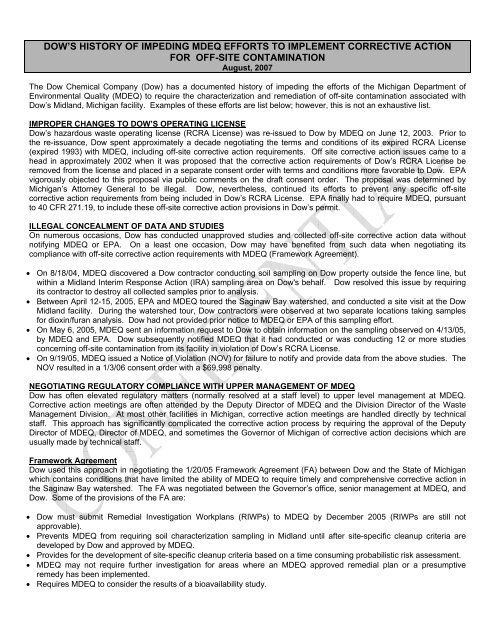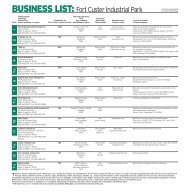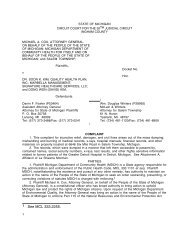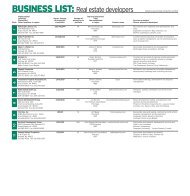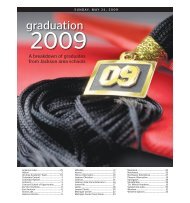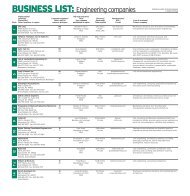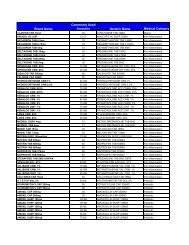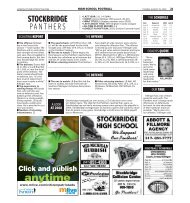confidential EPA memo - Tittabawassee River Watch
confidential EPA memo - Tittabawassee River Watch
confidential EPA memo - Tittabawassee River Watch
- No tags were found...
Create successful ePaper yourself
Turn your PDF publications into a flip-book with our unique Google optimized e-Paper software.
Legislative ActivitySignificant legislative activity has occurred with respect to off-site contamination which complicates the regulatorylandscape, and has required significant MDEQ staff resources for comment to the legislature.! 5/27/04 legislation was introduced in the house and senate to change the Michigan dioxin cleanup level to 1,000 ppt.Further action on the legislation was put on hold pending negotiations between the Governor’s office, Dow, and theMDEQ on a process to address the dioxin contamination in the Midland area.! In 2004 the House Appropriations Committee of the MI legislature approved legislation eliminating all funding forMDEQ’s Hazardous Waste Division, and cut the Director’s salary by 20 percent.! Later in 2004, the Michigan House Appropriations Committee withdrew legislation eliminating all funding for MDEQ'sHazardous Waste Division, and instead drafted a bill reducing MDEQ’s staffing levels by 8%, and general fund supportfor the department by 15%. Further action on this bill was delayed until meetings between the MDEQ, the Governor'soffice, and Dow reached an acceptable compromise (Framework Agreement).! On June 29, 2005 legislation was passed by the State House which would require that on-site testing show dioxin levelsin excess of the state's residential contact criteria of 90 parts per trillion before the “facility” designation is applied toproperty, and would require consideration of a risk assessment based on bioavailability and human exposure studies.! In 2006, a bill was introduced that would require MDEQ to “incorporate into a remedial action plan prepared or approvedunder this part area wide or site Specific cleanup criteria derived from peer-reviewed bioavailability studies, peerreviewedsite-specific human exposure data, and any other peer-reviewed scientifically based risk assessment studiesthat are available and relevant. A person who is or may be liable under section 20126 may submit to the departmentstudies or data described in this subsection, or other relevant information, including information that has not been peerreviewed, that the person believes may assist the department in developing or approving a remedial action plan.”! Dec. 2006 – a bill was signed into law stating that MDEQ may recalculate dioxin cleanup criteria based upon therecommendations in the 2006 NAS report on <strong>EPA</strong>’s draft Dioxin Reassessment.o This bill allows Dow to propose replacing the state’s current dioxin cancer slope factor with a morefavorable value. It should be noted that the development of cancer slope factors is usually done at thenational level using a consensus, peer reviewed process.o Dow is currently discussing with the state any necessary rule changes to allow for the replacement of thestate’s current dioxin cancer slope factor, since current state rules may be in conflict with the recentlypassed legislation.Political Activity! In early 2004, as a result of meetings between MDEQ, Dow, the Governor’s office, and State Legislators, soil samplingin the City of Midland which was to have started in 2004 was delayed until completion of a bio-availability study.! On February 24, 2004, Dow submitted the document Pilot Study Report: Oral Bioavailability of Dioxin/Furans in Midlandand <strong>Tittabawassee</strong> <strong>River</strong> Flood Plain Soils to MDEQ. However, soil sampling in Midland did not occur until 2006, partlydue to issues with the City of Midland.! In 6/04, MDEQ intended to issue a Scope of Work (SOW) to Dow (Dow was unable to provide an approvable SOW forover nearly a year). However, the SOW issuance was delayed while negotiations between MDEQ senior management,Dow, and the Governor’s office took place (Framework Agreement). The deadline for these negotiations was extended5 times.! On 1/19/05, MDEQ announced an agreement with Dow on a Framework document that was to lead Dow to beginimmediate work towards the cleanup of dioxin contamination in Midland, the <strong>Tittabawassee</strong> <strong>River</strong>, the Saginaw <strong>River</strong>,and Saginaw Bay. Characterization work did not begin until 8/06.! In response to <strong>EPA</strong>’s strongly worded comments on Dow’s <strong>Tittabawassee</strong> and Midland RIWPs sent on February 10,2006, a meeting took place in March between Tom Skinner, U.S. Congressman Dave Camp, and the City of Midland todiscuss <strong>EPA</strong>’s involvement in Dow’s corrective action.USE OF WORKING SESSIONS RATHER THAN NORMAL NOD AND RESUBMITTAL & DOW PROVIDESUNREALISTICALLY SHORT TIME FRAMES FOR DOCUMENT REVIEWDow frequently proposes to forgo the usual NOD process for submitted documents, and instead requests that issues beresolved using day-long working sessions. The working session approach has had the effect of limiting the administrativerecord, and places significant resource requirements on the MDEQ. <strong>EPA</strong> knows of no other facility in the State ofMichigan where this type of approach to corrective action has been allowed by MDEQ. In addition, Dow often providesunrealistically short time frames for MDEQ to review workplans prior to meetings, or requested approval dates.Documents are generally proved 1 day in advance, if that, which places MDEQ at a significant disadvantage since Dowoften requests MDEQ to make decisions on the spot at meetings.3
Midland and <strong>Tittabawassee</strong> <strong>River</strong> RIWPsAfter nearly 4 years since license issuance, Dow has yet to produce approvable workplans.! Fist submitted 12/29/05 (~21/2 years after license issuance due to lengthy delays in the SOW process)o Critically deficient (e.g. proposed 1 sample per river mile)o Unacceptable and time intensive proposed Human Health Risk Assessment (HHRA).! Does not follow <strong>EPA</strong> guidance/policy.! No accepted methodology (and none presented) for proposed approach.! Partially revised 5/1/06o Many of the remedial investigation component completion dates proposed by Dow will result in a delay ofthe initiation of final remedies until at least 2011 for the TR and 2017 for Midland. Based upon anestimate of 20 years for remedy implementation, the final remedies will not be complete until 2031 and2037.! Revised 12/1/06 (MDEQ provided a 6 month extension)o Incomplete (e.g. many significant sections submitted as “placeholders” where MDEQ and Dow will resolveissues through working sessions scheduled through at least 8/07).o Proposes same HHRA methodology that MDEQ and <strong>EPA</strong> identified as unacceptable in previous NODs.o MDEQ proposes to not issue an NOD (will resolve issues through biweekly working sessions).GeoMorph SAPsDow management refused to attend these meetings despite repeated requests from MDEQ and <strong>EPA</strong>. The limited timeframes for review and comment on the GeoMorph SAP documents were the direct result of the failure of ATS and Dow toprovide GeoMorph documentation according to the agreed-to schedules established during the April 26th, May 11th, andMay 18, 2006 GeoMorph meetings, schedules agreed upon during phone calls to <strong>EPA</strong> staff, and in the Responseincluding:! A draft SAP was due 5/16/06 according to the 4/26/06 GeoMorph meeting, and Dow’s 5/1/06 NOD response. ATSproposed to provide this document on May 24th during the 5/18/06 meeting. On 5/25/06, ATS stated that this documentwill be provided 6/1/06. On 6/1/06, an incomplete SAP was submitted.! ATS proposed to submit a draft SOP for the D/F analytical method by 5/26/06, and ATS submitted the draft SOP on6/1/06. ATS submitted revised version of the SOP on 6/15/06 and 6/16/06.! A draft PCOI study. ATS stated during the 4/26/06 GeoMorph meeting, and Dow’s 5/1/06 NOD response indicated thatit would be included in the SAP, but during the 5/18/06 meeting ATS stated that it may not be available until after 6/1/06.On 6/1/06, ATS submitted an incomplete PCOI study.! ATS stated in the 4/26/06 GeoMorph meeting, and Dow’s 5/1/06 NOD response indicated that that a draft Geochemistrystudy would be included in the SAP, but on 5/18/06, ATS stated that the geochemistry study will be conducted by Dow,will not be submitted for review and comment, and will be implemented without Agency oversight. On 5/25/06, ATSstated that the geochemistry study will be provided on 6/1/06, and MDEQ will need to approve it by 6/16/06. ATSprovided the Geochemistry study on 6/8/06, and a revised version on 6/14/06.! A. ATS indicated during the 5/11/06 GeoMorph meeting that they would provide a proposed methodology to test theGeoMorph hypothesis of homogeneity of geomorphic units, but did not provide a time frame. On 5/25/06, ATS statedthat this methodology will not be provided until 6/1/06. On 6/1/06, ATS provided an incomplete methodology, andsubmitted a more detailed methodology on 6/7/06.While Dow and ATS have habitually missed due dates for the above submittals, Dow maintained that MDEQ approval ofthe workplan by June 30 th was necessary for implementation in 2006. Dow stated that it expected to resolve many of theoutstanding issues through additional working meetings throughout the month of June. While the working sessions duringthe month of May achieved agreement on sampling transect sampling locations, the above issues have been continuouslyidentified by <strong>EPA</strong>, and then deferred to future dates for resolution. Additionally, ATS did not appear to have independentauthority to commit to agreements reached in the working meetings. The workplan was finally approved (while severalissues remained unresolved) and implementation began in 8/06. Working sessions are currently continuing to resolvesome of the above issues.Dow’s Failure to Send Decision Makers to Working SessionsAt working sessions (especially during the first half of 2006) Dow did not attended working sessions on numerousoccasions, instead choosing to be represented by its contractors. This has lead to occasions where apparent agreementwas reached with MDEQ, but later Dow indicates that it is not in agreement with the decisions made by its contactorrepresentatives at the meetings, and the issue had to be renegotiated again.4
Human Health Exposure Pathways Workgroup! Meetings occurred over a 6 month period in 2005 and agreement was reached between Dow’s contactors and MDEQ;however, none of the agreed upon pathway information was included in the 2006 RIWPs. Dow explained that they didnot agree with their contractors commitments.DOW PUTS FORTH PUBLIC INFORMATION THAT CONTRADICTS MDEQ OR CURRENT SCIENCEDow has frequently provided information to the public that contradicts Agency positions, and generally accepted scientificinformation. This has had the effect of confusing the public as to what information that they are hearing is correct.! On 7/9/04, Dow released a Wild Game Study that demonstrated that dioxin levels in game species are significantlyelevated downstream of Dow. However, Dow publicly stated that the wildlife is safe for human consumption. Thiscontradicted MDCH’s position which resulted in game consumption advisories being placed on the <strong>Tittabawassee</strong> <strong>River</strong>.! In 11/04, Dow mailed a newsletter to residents which stated:o Dioxin toxicity studies are inconclusive.o Humans are more dioxin resistant than test animals.o More studies must be completed so that any actions are based upon science.o Dow's recent worker health study shows few health effects associated with dioxin exposure.o A Dow study shows that dioxin is less bioavailable than believed.o Risk assessment models overestimate risks.o The dioxin congener mixture in the watershed is less toxic than previously thought.! On 11/9/04, Dow announced the results of a study of dioxin exposed workers. The study concluded that exposedworkers do not face any additional threat of illness. In addition, Dow stated that it is reasonable to reach the sameconclusion for residents along the <strong>Tittabawassee</strong> <strong>River</strong>.University of Michigan Dioxin Exposure StudyUnder a grant from Dow and pursuant to an unpublished contract with Dow, the University of Michigan has conducting astudy of dioxin exposure in the Saginaw Bay watershed. <strong>EPA</strong> does not consider the study to be particularly relevant tothe corrective action in this matter and believes the study was initiated at the request of Dow in order to downplay therisks of exposure to dioxin contaminated soils. While the University was quick to release its preliminary conclusions fromthe study the University has refused to share the data with MDEQ and <strong>EPA</strong>, and has not yet cooperated with numerousrequests to conduct additional analyses of the data, and UM will not provide a date by which the report will be completed.On August 15th, the University of Michigan released preliminary findings from a Dioxin Exposure Study funded by Dow.Initial results indicated that consumption of fish from the <strong>Tittabawassee</strong> and Saginaw <strong>River</strong>s is associated with elevateddioxin blood levels, and to a lesser extent, high levels of dioxin contamination in soils and household dust are associatedwith elevated dioxin blood levels. The results of the study are consistent with current <strong>EPA</strong>/MDEQ understanding, and willnot have any significant effect on corrective action activities. However, public presentations of the preliminary resultshave emphasized how little effect living on contaminated soils has one an individual’s dioxin blood level. This emphasishas resulted in numerous media stories, an understanding by some members of the public, that remediation of dioxincontamination is unnecessary.5


